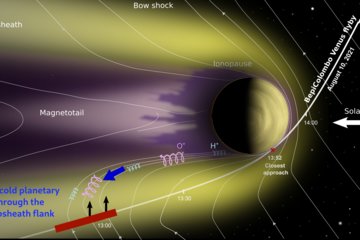All genres
101.
Journal Article
First evidence of interaction between longitudinal and transverse waves in solar magnetic elements. Astronomy and Astrophysics 554, A115 (2013)
102.
Journal Article
MHD simulation of the inner-heliospheric magnetic field. Journal Geophysical Research 118, pp. 29 - 44 (2013)
103.
Journal Article
Simulations of the solar near-surface layers with the CO5BOLD, MURaM, and Stagger codes. Astronomy and Astrophysics 539, A121 (2012)
104.
Journal Article
Waves as the Source of Apparent Twisting Motions in Sunspot Penumbrae. Astrophysical Journal 752, 128 (2012)
105.
Journal Article
Surface flux evolution constraints for flux transport dynamos. Astronomy and Astrophysics 542, A127 (2012)
106.
Journal Article
Are the strengths of solar cycles determined by converging flows towards the activity belts? Astronomy and Astrophysics 548, A57 (2012)
107.
Journal Article
Magnetohydrodynamics of the Weakly Ionized Solar Photosphere. Astrophysical Journal 750, 6 (2012)
108.
Journal Article
Break up of returning plasma after the 7 June 2011 filament eruption by Rayleigh-Taylor instabilities. Astronomy and Astrophysics 540, L10 (2012)
109.
Journal Article
Vortices, shocks, and heating in the solar photosphere: effect of a magnetic field. Astronomy and Astrophysics 541, A68 (2012)
110.
Journal Article
Quenching of the alpha effect in the Sun - what observations are telling us. First Asia-Pacific Solar Physics Meeting ASI Conference Series 2, pp. 143 - 147 (2011)
111.
Journal Article
Constructing Semi-Empirical Sunspot Models for Helioseismology. Solar Physics 268, pp. 293 - 308 (2011)
112.
Journal Article
Decay of a simulated mixed-polarity magnetic field in the solar surface layers. Astronomy and Astrophysics 533, A86 (2011)
113.
Journal Article
3D Numerical Simulations of f-Mode Propagation Through Magnetic Flux Tubes. Solar Physics 268, pp. 309 - 320 (2011)
114.
Journal Article
EUV Jets, Type III Radio Bursts and Sunspot Waves Investigated Using SDO/AIA Observations. Astronomy and Astrophysics 531, L13 (2011)
115.
Journal Article
The solar magnetic field since 1700 I. Characteristics of sunspot group emergence and reconstruction of the butterfly diagram. Astronomy and Astrophysics 528, A82 (2011)
116.
Journal Article
The solar magnetic field since 1700 II. Physical reconstruction of total, polar and open flux. Astronomy and Astrophysics 528, A83 (2011)
117.
Journal Article
Vortices in simulations of solar surface convection. Astronomy and Astrophysics 533, A126 (2011)
118.
Journal Article
Universality of the Small-scale Dynamo Mechanism. Astrophysical Journal 736, 36 (2011)
119.
Journal Article
Transport of Magnetic Flux from the Canopy to the Internetwork. Astrophysical Journal 729, 136 (2011)
120.
Journal Article
Is there a non-monotonic relation between photospheric brightness and magnetic field strength? Astronomy and Astrophysics 532, A140 (2011)











